Studying the area of building’s roof and parking shading of QU is a condition to determine the number of PV modules needed in that area and the power they generated. Based on the number of PV modules and electricity they generated, the number of selected inverters and how many PV modules in series and parallel connection in one array can be defined. Therefore, this study requires the data of all the nearest substations that can feed these six parking areas, which are: real power (P), reactive power (Q), voltage (V), and current (I). Also, the distance from the nearest substations to the parking area assists in determining the cable length. Also, based on the ETAP simulation, the parameters P, Q, V, I, and cable length and sizes are needed to find the losses in the power system. The analysis should include the spare capacity in kW for each substation that can feed the parking building. The extra capacity of the substations is necessary to check if the size of the transformer in the substation is enough to power the EVCS’s or not. In case the capability of the substations is enough to feed a certain EVCS, the analysis should include the calculation of how many EVCS can be powered through it. The buildings used in this study are Multi-floor Car parking, male student housing, female student housing, pharmacy college, and office building, as shown in the Figure 1.
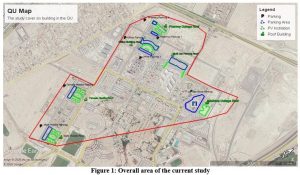
- Multi-floor Car Parking
The multi-floor car parking building, shown in Figure 2, can be fed from the nearest substations, which are those numbered 29086, 22196, and 24897.
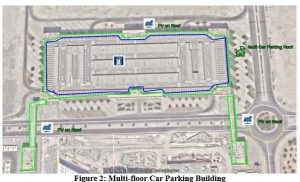
The real power, reactive power, voltage, and current obtained from ETAP. Note that the real power, reactive power, and voltage are used in this study to monitor system stability and power quality while the current is used for losses calculation, which relates to the economic constraint. Spare capacity of each substation can be calculated by finding the difference between total transformers rating inside the substation and the amount of current loads, as shown in Table 1.

Notice that the total losses of these three substations reaches 1.4 kW, and the full spare capacity reaches 3,375 kW. Note that the 29086 and 22196 substations are near to the building by distances of 150 and 400 meters, respectively. However, the 24897 substation is far away from the building by 650 meters, which leads to an increase in the losses by a cable that feeds the multi-floor car parking building.

Since the building consists of four levels, the best place to install the solar panels are on the rooftop of the building and the trail that connects the multi-floor car parking building with the New Engineer Building as shown in Figure 2. Therefore, the rooftop area of the multi-floor car parking with the trail is estimated at 6,800 m2.
- Office building
The office building can be fed from the nearest substations, which are numbers 29086, 22607, and 29086. As shown in Table 3, the total losses in these three substations reach 1.64 kW, and the full spare capacity reaches to 1,660 kW. From Table 4, the 24987 substation is the nearest substations to the building roof and parking with distances of 50 and 20 meters, respectively. However, the 22607 and 29086 substations are far away from the building around 1 km and 700 meters, respectively, which leads to more losses in the feeder cable.
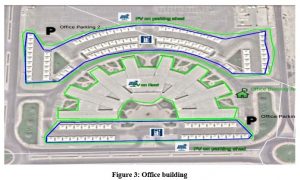


There are two possible locations for installing the solar panels, which are the office building rooftop and office parking shadings, as shown in Figure 3. The rooftop area of the office building is around 4,440 m2 and the office parking shading area is about 4,200 m2.
- Male and Female student housing
The male and female student housings are fed by the same four substations which are the nearest substations for both. These are the 19366, 19362, 19363, and 19364 substations. As shown in Table 5, the total losses of these four substations reach 6.5 kW, and the full spare capacity is about 6,620 kW.

Also, the solar panel can be placed on the male/female student housing building and parking shading as shown in Figure 4.
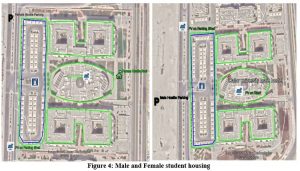
Therefore, the rooftop area of the male and female student housing building is around 5,600 m2 and its parking shading area is about 2,400 m2 as shown in Table 6.
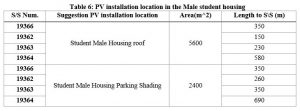
- Pharmacy College
The pharmacy college can be fed from the nearest substations, which are 22607 and 24987 as shown in Table 7.

The total losses of these two substations reach 1.1kW, and the full spare capacity reaches to 1160 kW. 22607 substation is near to the building by distance 50 meters as shown in Figure 5. However, the 24987 substation is far away from the building by 1 km, which leads to generating more losses by a cable that feeds pharmacy parking.
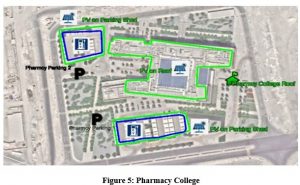

There are two possible locations to install the solar panel, which are the pharmacy building rooftop and pharmacy parking shading as shown in Figure 5. The rooftop area of the pharmacy building is around 6,000 m2 and there are two parking shaded areas covering about 2,000 m2.